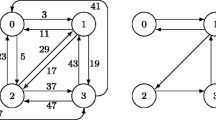Abstract
The complexity theoretic concept of levelability is introduced to the accepting density hierarchy inNP. A setA inNP islevelable with respect to densityu(n) if for every polynomial-time nondeterministic Turing machine (NTM)M that acceptsA there is a better NTMM′ forA that improves the accepting density ofM infinitely often from the density belowu(n) tou(n). We investigate the structural properties of nonlevelable sets inNP. A nonlevelable set must have a maximal complexity core, and its maximal cores must have relatively low complexity. Most naturalNP-complete sets are paddable and hence levelable with respect to the two lowest levels in the accepting density hierarchy. A relativized accepting density hierarchy is constructed to demonstrate the possibility of the existence of nonlevelable sets at each level of the hierarchy.
Similar content being viewed by others
References
Adleman, L., Two theorems on random polynomial time,Proc. 19th IEEE Symp. on Foundations of Computer Science (1978), 75–83.
Angluin, D., On counting problems and the polynomial-time hierarchy,Theoret. Comput. Sci. 12 (1980), 161–173.
Balcazar, J. and D. Russo, Immunity and simplicity in relativizations of probabilistic complexity classes, preprint.
Balcazar, J. and U. Schöning, Bi-immune sets for complexity classes,Math. Systems Theory, (to appear).
Bennett C. H. and J. Gill, Relative to a random oracleA, P a ≠NP A ≠ coNP A with probability 1,SIAM. J. Comput. 10 (1981), 96–113.
Berman, L. On the structure of complete sets: almost everywhere complexity and infinitely often speedup,Proc. 17th IEEE Symp. on Foundation of Computer Science (1976) 76–80.
Berman, L. and J. Harmanis, On isomorphisms and density ofNP and other complete sets,SIAM J. Comput. 6 (1977), 305–322.
Blum M. and I. Marques, On complexity properties of recursively enumerable sets,J. Symbol. Logic 38 (1973), 579–593.
Cook, S., A hierarchy for nondeterministic time complexity,J. Comput. System Sci. 7 (1973) 343–353.
Even, S., A. Selman and Y. Yacobi, Hard-core theorems for complexity classes,J. Assoc. Comput. Mach. (1985), to appear.
Garey, M. and D. Johnson,Computers and Intractability, W. H. Freeman, San Francisco, 1979.
Gill, J., Computational complexity of probabilistic Turing machines,SIAM J. Comput. 6 (1977), 675–695.
Hartmanis, J., Generalized Kolmogorov complexity and the structure of feasible computations,Proc. 24th IEEE Symp. on Foundation of Computer Science (1983) 439–445.
Homer, S. and W. Maass, Oracle dependent properties of the lattice ofNP sets,Theoret. Comput. Sci. 24 (1983), 279–289.
Karp, R. and R. Lipton, Some connections between nonuniform and uniform complexity classes,Proc. 12th ACM Symp. Theory of Comput. (1980), 302–309.
Kintala, C. and P. Fischer, Refining nondeterminism in relativized polynomial time bounded computations,SIAM J. Comput. 9 (1980) 46–53.
Ko, K. and D. Moore, Completeness, approximation and density,SIAM J. Comput. 10 (1981), 787–796.
Ko, K. and U. Schöning, On circuit-size complexity and the low hierarchy inNP, SIAM J. Comput. (1985), 41–51.
Lautemann, C., BPP and the polynomial hierarchy,Inform. Proc. Letters 17 (1983), 215–217.
Lynch, N., On reducibility to complex or sparse sets,J. Assoc. Comput. Mach. 22 (1975) 341–345.
Moran, S., On the accepting density hierarchy inNP, SIAM J. Comput. 11 (1982) 344–349.
Orponen, P., A classification of complexity core lattices, preprint.
Orponen, P., D. Russo and U. Schöning, Optimal approximations and polynomially levelable sets, SIAM J. Comput., to appear.
Orponen, P. and U. Schöning, The structure of polynomial complexity cores,Proc. 11th Symposium on Mathematical Foundations of Computer Science, Lecture Notes in Computer Science 176 (1984), 452–458.
Papadimitriou, C. H. and M. Yanakakis, The complexity of facets,Proc. 14th ACM Symp. on Theory of Computing (1982), 255–260.
Rabin, M., Probabilistic algorithms, inAlgorithm and Complexity, J. F. Traub, ed., Academic Press (1976) 21–39.
Rackoff, C., Relativized questions involving probabilistic algorithms,J. Assoc. Comput. Mach. 29 (1982), 261–268.
Schöning, U., A low and a high hierarchy withinNP, J. Comput. System Sci. 27 (1983) 14–28.
Schöning, U. and R. Book, Immunity, relativizations and nondeterminism,SIAM J. Comput. 13 (1984), 329–337.
Seiferas, J., M. Fischer and A. Meyer, Separating nondeterministic time complexity classes,J. Assoc. Comput. Mach. 25 (1978) 146–167.
Sipser, M., A complexity theoretic approach to randomness,Proc. 15th ACM Symp. on Theory of Computing (1983) 330–335.
Soare, R., Computational complexity, speedable and levelable sets,J. Symbolic Logic, 42 (1977) 545–563.
Stockmeyer, L., The polynomial time hierarchy.Theoret. Comput. Sci. 3 (1976) 1–22.
Valiant, L. G., The complexity of computing the permanent,Theoret. Comput. Sci. 8 (1979), 189–201.
Valiant, L. G., The complexity of reliability and enumeration problems,SIAM J. Comput. 8 (1979), 410–421.
Author information
Authors and Affiliations
Additional information
This research was supported in part by the National Science Foundation under Grants MCS-8103479 and MCS-8103479A01.
Rights and permissions
About this article
Cite this article
Ko, KI. Nonlevelable sets and immune sets in the accepting density hierarchy inNP . Math. Systems Theory 18, 189–205 (1985). https://doi.org/10.1007/BF01699469
Received:
Revised:
Issue Date:
DOI: https://doi.org/10.1007/BF01699469




